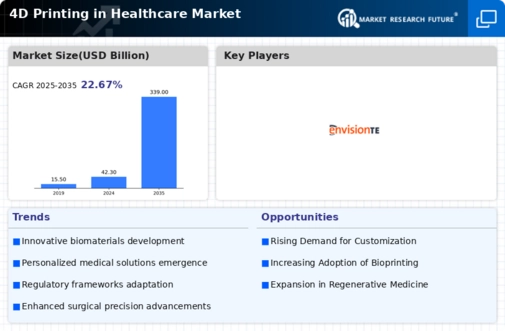Market Growth Projections
Technological Advancements
The Global 4D Printing in Healthcare Market Industry is propelled by rapid technological advancements in materials and printing techniques. Innovations such as shape-memory polymers and bio-inks enable the creation of dynamic structures that can respond to environmental stimuli. For instance, researchers have developed 4D printed scaffolds that can change shape in response to temperature variations, enhancing tissue engineering applications. This evolution in technology is expected to contribute to the market's growth, with projections indicating a market value of 42.3 USD Billion in 2024, highlighting the increasing adoption of 4D printing technologies in healthcare.
Regulatory Support and Standardization
Regulatory support and standardization play a pivotal role in the Global 4D Printing in Healthcare Market Industry. Governments and regulatory bodies are increasingly recognizing the potential of 4D printing technologies in healthcare, leading to the establishment of guidelines and standards that facilitate innovation. For instance, the U.S. Food and Drug Administration has initiated frameworks to evaluate 3D and 4D printed medical devices, ensuring safety and efficacy. This regulatory backing not only boosts industry confidence but also encourages investment and research, further propelling market growth.
Rising Demand for Personalized Medicine
The Global 4D Printing in Healthcare Market Industry is increasingly influenced by the rising demand for personalized medicine. As healthcare shifts towards tailored treatments, 4D printing offers the potential to create customized implants and prosthetics that fit individual patient anatomies. This personalization enhances patient outcomes and satisfaction. For example, 4D printed orthopedic implants can be designed to adapt to the specific biomechanical needs of patients, thereby improving recovery times. The market is projected to reach 339.0 USD Billion by 2035, reflecting the growing emphasis on personalized healthcare solutions.
Cost Efficiency and Resource Optimization
Cost efficiency and resource optimization are critical drivers in the Global 4D Printing in Healthcare Market Industry. 4D printing technologies can significantly reduce material waste and production costs compared to traditional manufacturing methods. By utilizing smart materials that can change properties, healthcare providers can minimize inventory costs and streamline production processes. For instance, hospitals can produce on-demand surgical tools tailored to specific procedures, reducing the need for extensive storage. This efficiency is likely to attract more investments, contributing to a compound annual growth rate of 20.83% from 2025 to 2035.
Growing Applications in Tissue Engineering
The Global 4D Printing in Healthcare Market Industry is significantly driven by the growing applications in tissue engineering. 4D printing enables the fabrication of complex tissue structures that can mimic natural biological processes. For example, researchers are exploring 4D printed vascular networks that can enhance the viability of transplanted tissues. This capability is crucial for regenerative medicine and organ transplantation, as it addresses the challenges of tissue integration and functionality. The expanding applications in tissue engineering are expected to contribute to the market's robust growth trajectory.











